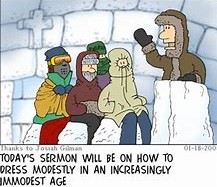Clothing is notoriously associated with legalism, and rules. “Not more than three fingers above the knee, three fingers below the neckline” “No pants”.  The reaction to stringent rules about clothing and dress codes has produced an unfortunate backlash which dresses rebelliously, or thoughtlessly. The motto today becomes “God looks at the heart, not the clothes”.
The reaction to stringent rules about clothing and dress codes has produced an unfortunate backlash which dresses rebelliously, or thoughtlessly. The motto today becomes “God looks at the heart, not the clothes”.
But we have to consider why churches concerned with holiness have been prone to make rules. The younger generation assumes it is because they were legalists and hated freedom. They seem to miss the fact that when fashions are rapidly changing, it’s natural to try to make a standard of modesty practical by spelling things out in detail.
The problem is not making rules. Every responsible parent is going to teach children modesty, and going to get down to brass tacks – “too short, too form-fitting, too loose”. If it is not sinful for a parent to say so, it is not sinful, in principle, for a Christian to say so to another Christian in a discipleship relationship.
If it is not sinful for a parent to say so, it is not sinful, in principle, for a Christian to say so to another Christian in a discipleship relationship.
The real problem is twofold. One, fashions change, and the meaning of the fashions changes with it. Like music, there are aspects of meaning which are intrinsic to the human body, and aspects of meaning that are culturally formed. Revealing certain parts of your body is going to be sexually provocative for all people of all times. On the other hand, certain cultures place different meanings on things such as pants, certain colours, shorts etc.
The second problem is binding Christian’s consciences in areas where an amount of differing choice is allowed. There can be certain contexts where a mandatory dress code is enforced (a Christian school, for example), but in the church, the norm has to be teaching principles, and helping the less mature through direct discipleship.
Instead, Christians need to understand the biblical principles.
Biblical Principles Regarding Dress
- Modesty. Modesty is much more than how much thigh or cleavage is revealed. Modesty begins with the desire to be moderate in one’s appearance before others. “How does a woman discern the sometimes fine line
 between proper dress and dressing to be the center of attention? The answer starts in the intent of the heart. A woman should examine her motives and goals for the way she dresses. Is her intent to show the grace and beauty of womanhood? Is it to reveal a humble heart devoted to worshiping God? Or is it to call attention to herself and flaunt her beauty? Or worse, to attempt to lure men sexually? A woman who focuses on worshiping God will consider carefully how she is dressed, because her heart will dictate her wardrobe and appearance.” -John MacArthur.
between proper dress and dressing to be the center of attention? The answer starts in the intent of the heart. A woman should examine her motives and goals for the way she dresses. Is her intent to show the grace and beauty of womanhood? Is it to reveal a humble heart devoted to worshiping God? Or is it to call attention to herself and flaunt her beauty? Or worse, to attempt to lure men sexually? A woman who focuses on worshiping God will consider carefully how she is dressed, because her heart will dictate her wardrobe and appearance.” -John MacArthur.
Consider the descriptions of the character of modesty:
- 1 Tim 2:9-10
Notice the words: modest apparel = kosmiois “respectable” “in accordance with decency”; with propriety = aidous “reverent, unpretentious, respectful shyness, reserve, reticence”; and moderation = sophrosunys “self-controlled, reasonable, of sound judgement”.
The contrast: “not with braided hair or gold or pearls or costly clothing” (1 Tim. 2:9). Is Paul forbidding braided hair, jewelry or expensive clothes? No. The contrast is between unpretentious and pretentious, between reserved and flamboyant, between respect of others and thrusting oneself forward to the the centre of attention.
Practically: this looks like service and teachability. “...but, which is proper for women professing godliness, with good works. 11 Let a woman learn in silence with all submission.” (1 Tim. 2:10-11)
Another contrast: Proverbs 7:5-12. Notice she is “loud and rebellious” “her feet do not abide at home”. Notice then her clothing outwardly represents the state of her heart.
- 1 Peter 3:3-4
The adornment is not to be merely external. The adornment begins within. What inner adornment befits the greatest women of the faith according to verse 5?
A gentle (praus) spirit = mild, gentle; quiet (hesuchios) spirit = tranquil, at rest, not unruly.
Modesty of the heart, then, is going to be worked out into what is worn, and when.
There is a clear distinction between dressing for beauty, and dressing for sexual attraction. One adorns your person, and brings attention to your face. Another invites prurient glances at your body for sexual thoughts. One adds elegance and beauty, another advertises one’s body. One encourages others to consider you as a person, another encourages them to notice your sexuality.
Matthew 5 condemns lust in the mind as a form of adultery. It is possible for a man to lust after a woman even if she is covered from head to toe. It is also possible for a man to resist lusting after a very provocatively  dressed woman (and he should). But once we have agreed that onlookers have a moral responsibility to be pure in thoughts, do we not also have a loving responsibility to help onlookers to do so? Is it loving to your neighbor to make it easier to lust, or harder to resist doing so? This goes back to the inner qualities of modesty.
dressed woman (and he should). But once we have agreed that onlookers have a moral responsibility to be pure in thoughts, do we not also have a loving responsibility to help onlookers to do so? Is it loving to your neighbor to make it easier to lust, or harder to resist doing so? This goes back to the inner qualities of modesty.
At some point, this does come down to whether something is too short, too low, too thin, too form fitting, too tight, or too loose.
This applies to the swimming pool and beach, too. Certainly swimming requires we wear less, but should Christians, when swimming in a public venue or mixed company, wear what leaves almost nothing to the imagination? Why is wearing lingerie in public okay if we make it waterproof and call it a bikini?
 – David De Bruyn, Professor of Church History, Shepherds’ Seminary Africa
– David De Bruyn, Professor of Church History, Shepherds’ Seminary Africa

